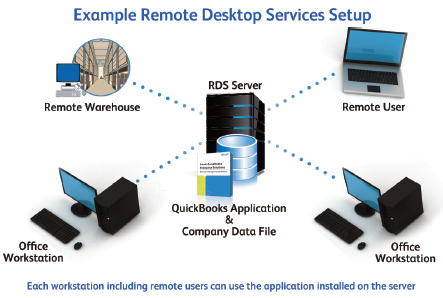Not all small businesses can afford QuickBooks Hosting. But, many businesses can’t afford not to. A small business must make a solid business case to spend $50 per user on Hosted QuickBooks. Make the business case and you too can spend many years using QuickBooks Pro, Premier, Accountant or Enterprise Solutions trouble free.
If your business can’t make the case for Hosted QuickBooks, consider this unorthodox route to your own QuickBooks Multi User, Remote Access QuickBooks Server.
The process to build what you need is very straight forward. It will work for 3 user Pro or Premier. If you use a re purposed XP Pro computer, you can save quite a bit of money. The steps are below.
Build a new XP Pro or Win7 Pro computer.
Assign to a domain if it needs to be part of your domain.
Download and Install per their instructions the appropriate version of Thinstuff XP/VS Terminal Server (http://www.thinstuff.com)
Install your version of QuickBooks Pro or Premier.
Setup domain security or local user security.
Turn off any firewall software on the server or write rules to allow rdp and vpn.
Test multiuser desktop access on the local network.
Setup QuickBooks users.
Test multiuser QuickBooks access on the local network.
You now have a multiuser RDP accessible QuickBooks server.
You can use XP/VS Terminal Server to serve a desktop or TSX RemoteApp to serve only QuickBooks.
To add remote access to the server, install OpenVPN or LogMeIn Hamachi VPN on the server and on client computers. You can then access QuickBooks from anywhere you have fast broadband Internet.
Compare this to my Enterprise Solutions server by the book setup:
Remote Desktop Services with Microsoft Windows Server 2008 R2 standard with the latest Intel 64 bit processors, 32 GB RAM and 1000GB drive (not raid) for serving thirty users’ desktops, the maximum size for a single Enterprise installation on a physical server. Add a backup/recovery scheme and redundancy to power and memory to allow for maximum uptime. For a datacenter, dedicate one physical server and network segment to one unique business.
One can save a ton of money.



6 thoughts on “QuickBooks Multi User QuickBooks Server QuickBooks Remote Access”
Thanks Les. We have an in-house server running the same platform as what you’re recommending (Server 2008 R2 w/ RDS). However, we are having trouble justifying an upgrade from QB Pro -> Enterprise. Running multiple instances of Pro via RDS seems to work just fine, even though it’s not officially Intuit-supported. That being said, there are still some concerns about data integrity in this unsupported use model.
While you were still on Pro in a multi-user ThinStuff/RDS environment, was there any questionable QuickBooks behavior that may have been due to Pro/Premiere?
On a side note, I’m slowly starting to come around to your cloud-based, remote-managed QB hosting recommendation. I’m a veteran software developer with decent IT experience and thought keeping the hw and software installs in-house could save us some money. While we probably have saved a few bucks, the licensing, installation, and maintenance headaches are pretty formidable (and I know what I’m doing!).
Thanks for the useful posts-
Jonathan
Regarding Pro in a multi-user ThinStuff/RDS environment, my needs were simple. There were no questionable behaviors related to the environment. However, today my clients almost always require more than three users, placing them outside of Pro’s limitations. Consequently, the cost of QuickBooks Enterprise does not seem to be an issue, especially when folks talk about growing.
Hey Les-
Great write-up. It seems that ThinStuff is competing with Windows Server’s available Remote Desktop Services (formerly Terminal Services) component. I haven’t compared the functionality of the two, but the price on ThinStuff is certainly appealing.
Intuit only supports Windows RDS for their Enterprise Edition of QuickBooks. This restriction would likely apply to any RDS-like service. I assumed that Enterprise added some features that allowed for simultaneous sessions on the same host PC.
Have you had any issues running simultaneous Pro or Premiere sessions in this ThinStuff environment? Does it concern you that Intuit doesn’t technically support having multiple instances of Pro / Premiere hosted on one box?
Thanks-
Jonathan
Thanks for the comment Jonathan. As for your questions; when I wrote the article in 2011, I had no issues with ThinStuff or concerns about Intuit’s support. However, things change. Not only have I out grown the solution, but virtualization and newer versions of software present more opportunities. I’ve since moved on to QuickBooks 2012 on Server 2008 R2 Remote Desktop Services, primarily because my clients need to be supported under Intuit’s umbrella and the combination runs so well in a virtualized environment. My standard five user setup is here.
Les,
I setup one of these boxes for a client recently. We went back and forth with various hosted application and hosted server providers. The biggest problem we had was the providers couldnt give us any kind of security SLA; not could they provide us with information as to who has access to the data in the cloud. Basically it came down to security. No provider out there can guarantee your data is safe.
So we purchased the 5 user licenced version of software from thinstuff.com. Created the user accounts on Windows 7 computer we bought from Costco; and we are running Quickbooks 2011 Pro, 3 user. It also integrates well with the Billquick 2011, billing software thats on there by BQE software.
Remote users have access to quickbooks, billquick, office 2010, and adobe from all over the country. It connected to a dedicated DSL line with static IP and Cisco/Linksys RV042 router. Setup is pretty simple, it just takes a little bit of time; like you said.
This setup has been running fine for the past 9 months.
Thanks again for the tip
Jason
Glad to hear about your success. Security plays a significant part in any decision regarding hosted applications. There are times that it pays to be able to put your hands on the box that holds your data and play a part in securing that data.